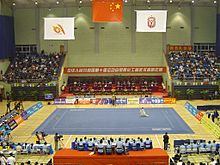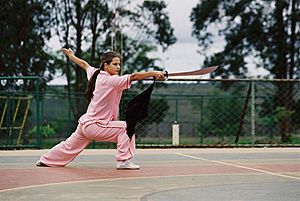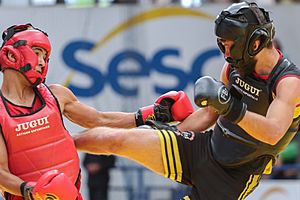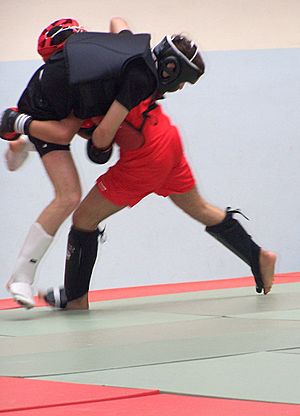Wushu (sport) facts for kids
 |
|
| Also known as | Kung fu, CMA, WS |
|---|---|
| Focus | Striking, Grappling, Throwing, Performance Martial Art |
| Country of origin | Greater China |
| Famous practitioners | See: Category:Wushu practitioners |
| Highest governing body | International Wushu Federation |
|---|---|
| First played | China |
| Characteristics | |
| Contact | Dependent on type of Wushu |
| Team members | Individuals or Team |
| Mixed-sex | Yes |
| Type | Martial art |
| Venue | Taolu Carpet or Lei Tai (fighting arena) |
| Presence | |
| Country or region | Worldwide |
| Olympic | (Unofficial Sport) 2008 |
| World Championships | 1991 |
| World Games | (Invitational Sport) 2009, 2013, 2022 |
| Wushu | |||||||||||||||||||||||||
|---|---|---|---|---|---|---|---|---|---|---|---|---|---|---|---|---|---|---|---|---|---|---|---|---|---|
| Traditional Chinese | 武術 | ||||||||||||||||||||||||
| Simplified Chinese | 武术 | ||||||||||||||||||||||||
| Literal meaning | "Martial arts" | ||||||||||||||||||||||||
|
|||||||||||||||||||||||||
Wushu, also known as Kung fu, is a type of martial art and a full-contact combat sport. It has a long and rich history in China. Wushu was created in 1949 to make traditional Chinese martial arts more organized. However, efforts to structure these arts began even earlier, in 1928, with the Central Guoshu Institute in Nanjing.
The word "Wushu" comes from Chinese. "Wu" (武) means combat or martial, and "Shu" (術) means art. So, Wushu means "martial arts." Today, Wushu is an international sport managed by the International Wushu Federation (IWUF). They hold the World Wushu Championships every two years. Wushu is also a recognized event at many major sports competitions, like the Asian Games.
Contents
Understanding the Name Wushu
The Chinese character for "wu" (武) means 'martial'. It is made up of two parts. One part means "walk" or "stop" (止). The other part means "lance" (戈). This shows that "wu" is about using combat for defense.
The term "wushu" (武術) has been used for 'martial arts' for a very long time. It appeared in a collection of writings from the Liang Dynasty (502–557 AD). This collection was put together by Xiao Tong.
The earliest term for 'martial arts' was "military fighting techniques." This was found in the Han History (206 BC-23 AD). Around 960 AD, during the Song period, the name changed to "martial arts" (武藝). In 1928, it was called "national arts" (國術) when the National Martial Arts Academy opened in Nanjing. The name went back to "wushu" in the 1950s under the People's Republic of China.
The History of Wushu
In 1958, the Chinese government created an organization to manage martial arts training. The Chinese State Commission for Physical Culture and Sports helped create standard forms for most major martial arts styles. During this time, a national Wushu system was set up. This system included standard forms, a teaching plan, and ways to grade instructors.
Wushu was also introduced in high schools and universities. This new system aimed to combine common parts from all styles. It brought together ideas like hard and soft, internal and external. It also included styles like Shaolin, Tai chi, and Wudang. Wushu became the official way martial arts were taught in China.
In 1979, a special team was made to improve Wushu teaching and practice. In 1986, the Chinese National Research Institute of Wushu was created. This group became the main authority for Wushu activities in China. Today, both traditional styles and modern Wushu are promoted by the International Wushu Federation.
Taolu: Wushu Routines
Wushu events often involve performing routines called taolu (套路). These can be compulsory routines or individual routines. From the 1990s to 2005, athletes in international events used routines choreographed by coaches or athletes approved by the IWUF.
In 2003, the rules for taolu competitions changed a lot. Judges' roles were expanded, and a "degree of difficulty" part, called nandu (難度), was added. This part is worth 2 points out of 10. The quality of movements is worth 5 points, and overall performance is worth 3 points.
These changes started at the 2005 World Wushu Championships. Now, athletes usually create their own routines with their coaches. They must follow certain rules for difficulty and technical moves. Only younger athletes (age groups C and B) at the World Junior Wushu Championships still use compulsory routines.
Besides individual routines, some Wushu competitions also have dual and group events. The dual event, or duilian (对练), is like a choreographed fight. It can be with or without weapons. The group event, or jiti (集體), involves a team performing together. Everyone must move in perfect sync. Music often goes along with group performances. The carpet for group events is also bigger. The 2019 World Wushu Championships was the first international Wushu competition to include this event.
Barehanded Routines
- Changquan (Chinese: 长拳; lit. 'Long fist') is a popular and challenging event. It comes from styles like Chāquán, Huaquan, and Shaolinquan. Changquan needs great speed, power, accuracy, and flexibility. Many professional athletes in China start training this style when they are young.
- Nanquan (Chinese: 南拳; lit. 'Southern fist') comes from styles in southern China, such as Hongjiaquan and Cailifoquan. Nanquan needs less flexibility and fewer acrobatics than Changquan. But it requires strong leg stability and power from the legs and hips.
- Taijiquan (Chinese: 太极拳; lit. 'Grand ultimate fist') as a Wushu routine is mostly based on the Yang style of Taijiquan. It also includes moves from the Chen, Wu, and Sun styles. Competitive Taiji is different from traditional forms. It often has difficult balances and jumps that need great control and flexibility. Taijiquan routines are usually performed with music.
Short Weapons Routines
- Daoshu (Chinese: 刀术; lit. 'Broadsword') uses a broadsword with Changquan movements.
- Jianshu (Chinese: 剑术; lit. 'Straightsword') uses a straightsword with Changquan movements.
- Nandao (Chinese: 南刀; lit. 'Southern broadsword') was added to international Wushu in 1999. The weapon is based on the butterfly swords from southern styles. It uses a single, longer sword.
- Taijijian (Chinese: 太极剑; lit. 'Tai Chi straightsword') uses a straightsword based on traditional Taijiquan sword methods. This event was added in 1999.
- Taijishan (Chinese: 太极扇; lit. 'Tai Chi fan') uses a Chinese Hand fan with traditional Taijiquan methods. This event was created for the 2026 Summer Youth Olympics (originally 2022).
Long Weapons Routines
- Gunshu (Chinese: 棍术; pinyin: Gùn shù; lit. 'Cudgel') uses a staff with Changquan movements. Staffs were traditionally made from white wax wood. Now, carbon fiber staffs are common because they are lighter and stronger.
- Qiangshu (Chinese: 枪术; pinyin: Qiāng shù; lit. 'Spear') uses a spear with Changquan movements. The spear shaft is usually more flexible and longer than a staff.
- Nangun (Chinese: 南棍; pinyin: Nán gùn; lit. 'Southern cudgel') was added to international Wushu in 1999. It uses a staff with Nanquan movements. This staff is generally thicker and heavier than the one used in Gunshu.
Many routines in Wushu are new, modern versions of older traditional routines. However, routines taken directly from traditional styles can also be performed in competitions, especially in China. Many of these traditional styles are featured in the World Kung Fu Championships, another event run by the IWUF.
Common traditional routines include:
- Baguazhang (八卦掌) – Eight-Trigrams Palm
- Bajiquan (八極拳/八极拳) – Eight Extremes Fist/Boxing
- Chāquán (查拳) – Cha Fist/Boxing
- Chuōjiǎo (戳腳/戳脚) – Poking Feet
- Ditangquan (地躺拳) – Ground-Prone Fist/Boxing
- Fānziquán (翻子拳) – Tumbling Fist/Boxing
- Houquan (猴拳) – Monkey Fist/Boxing
- Huaquan (華拳/华拳) – Hua Fist/Boxing
- Nanquan (南拳) – Southern Fist
- Pào Chuí (炮捶) – Cannon Punch
- Piguaquan (劈掛拳) – Chop-Hitch Fist/Boxing
- Shequan (蛇拳) – Snake Fist/Boxing
- Tán Tuǐ (弹腿) – Spring Kick
- Tang Lang (螳螂拳) – Praying Mantis Fist/Boxing
- Tongbeiquan (通背拳) – Through-the-Back Fist/Boxing
- Wing Chun (詠春拳/咏春拳) – Eternal Spring
- Xing Yi Quan (形意拳) – Shape-Intent Fist/Boxing
- Ying Zhao Pai (鷹爪拳/鹰爪拳) – Eagle Claw Fist/Boxing
- Zui Quan (醉拳) – Drunken Fist/Boxing
Traditional Weapons Routines
There is also a category for traditional weapons routines. These often include:
- Shuangshoujian (雙手劍/双手剑) – Two-Handed Sword
- Jiujiebian (九節鞭/九节鞭) – Nine Section Whip
- Sanjiegun (三節棍/三节棍) – Three Section Staff
- Shengbiao (繩鏢/绳镖) – Rope Dart
- Dadao (大刀) – Great Sword
- Pudao (撲刀/扑刀) – Horse Knife
- Emeici (峨嵋刺) – Emei Daggers
- Shuangdao (雙刀/双刀) – Double Broadsword
- Shuanggou (雙鈎/双钩) – Double Hook-sword
Sanda: Wushu Combat Sport
Another main part of modern Chinese Wushu is Sanda. It is also called Sport Free-Fighting or Competitive Free-Fighting. Sanda is a modern fighting method and sport. It is influenced by traditional Chinese boxing. In Sanda, takedowns and throws are allowed, along with all kinds of strikes using arms and legs. It also includes Chinese wrestling methods like Shuai Jiao and other Chinese grappling techniques. Sanda has all the combat parts of Wushu.
Sanda looks a lot like Kickboxing or Muay Thai. However, it includes many more grappling techniques. Sanda fighting competitions are often held at the same time as taolu competitions. Sanda is the modern version of old Lei Tai contests, but with rules to make it safer. Many Chinese martial arts schools teach Sanda rules. They try to include their style's movements and ideas into Sanda.
Chinese martial artists also compete in other combat sports. These include Boxing, Kickboxing, and Mixed Martial Arts. Sanda is practiced in tournaments and usually happens alongside taolu events. For safety, some self-defense moves like elbow strikes, chokes, and joint locks are not allowed in tournaments.
Fighters can win by knockout or by earning points. Points are given for landing strikes to the body or head, throwing an opponent, or pushing them off the raised platform (Lei Tai). Fighters can only hold onto each other for a few seconds. If they don't break the clinch or throw their opponent, the referee will separate them. In the U.S., competitions are held in boxing rings or on the Lei Tai platform. Amateur fighters wear protective gear.
Amateur Sanda allows kicks, punches, and throws. Professional Sanda, seen in events like King of Sanda in China, is held in a ring. Professionals wear less protective gear, only gloves, a cup, and a mouthpiece. Professional Sanda also allows knee and elbow strikes, even to the head, along with kicking, punching, and throwing.
Some Sanda fighters have done well in other fighting tournaments. These include K-1, Muay Thai, boxing, and Shoot Boxing. They have been quite successful, especially in Shoot Boxing, which is similar to Sanda. Many top fighters in China's Mixed Martial Arts competitions come from a Wushu background. Sanda is often matched against other styles like Muay Thai, karate, kickboxing, and Tae Kwon Do.
Wushu Competitions
Here are some major international and regional competitions where Wushu is featured:
- World Wushu Championships
- World Junior Wushu Championships
- World Games (2009, 2013, 2022)
- World Combat Games
- Asian Games
- East Asian Games
- East Asian Youth Games
- National Games of China
- South Asian Games
- Southeast Asian Games
- Mediterranean Games
- Lusofonia Games
Wushu is not a regular Summer Olympic sport. The IWUF has tried many times to get Wushu added to the Olympic program. For example, they proposed it for the 2020 Summer Olympics in Tokyo, Japan, but it was not chosen. However, Wushu was shown as an exhibition sport at the 1936 Summer Olympics in Berlin.
In 2015, the IWUF planned to propose Wushu again for the 2024 Summer Olympics. Also, new Olympic rules allow host cities to suggest new sports. Wushu was again shortlisted for the 2020 Games under these rules, but it didn't make the final list. On January 8, 2020, the IOC announced that Wushu will be part of the 2022 Summer Youth Olympics (now scheduled for 2026).
Because Wushu is so important in Chinese culture, the IOC allowed the organizers of the 2008 Summer Olympics in Beijing to hold a Wushu tournament at the same time as the Games. This was the first time the IOC allowed such a separate event. Wushu was also a demonstration sport at the 2014 Summer Youth Olympics in Nanjing.
Famous Wushu Practitioners
- Wu Bin (吳彬/吴彬) – He was Jet Li's coach in the Beijing Wushu Team. He has trained more Wushu champions than any other coach in China.
- Jet Li (李連杰/李连杰) – He is probably the most famous Wushu practitioner in the world. He started Wushu as a sport and won the National Wushu Champion of China title five times. He was a member of the Beijing Wushu Team. He became famous after showing his Wushu skills in the movie Shaolin Temple. Many of his old teammates have also appeared in his movies.
- Donnie Yen (甄子丹) – A Chinese martial artist and actor. He trained with the Beijing Wushu Team and won gold medals in international Wushu Competitions. He is well-known for playing Ip Man, who was Bruce Lee's mentor.
- Wu Jing (吳京/吴京) – A Chinese actor who started training at the Beijing Sports Institute at age 6. Like Jet Li, he competed in national Wushu competitions as part of the Beijing Wushu Team. His father and grandfather were also martial artists.
- Ray Park – He showed his Wushu skills in several major films. These include playing Darth Maul in Star Wars: Episode I – The Phantom Menace (1999) and Toad in X-Men (2000). He also worked as a stunt-double in Mortal Kombat: Annihilation. He trained a lot for G.I. Joe: The Rise of Cobra, where he played the martial arts expert Snake Eyes.
- Jon Foo – He started learning Kung Fu at 8 and began serious Wushu training at 15. He played Jin Kazama in the movie Tekken.
- Jade Xu (徐慧慧) – A martial arts actress and multiple World Wushu Champion. She won the World Championships three times in a row. She also took first and second place in the Olympic Wushu Tournament Beijing 2008. She became one of the most famous female Wushu athletes. After her sports career, Jade Xu became an actress in international films like Tai Chi 0 and Tai Chi Hero.
- Muslim Salikhov – He is a very skilled Sanshou fighter. He has competed in MMA competitions like the UFC. Salikhov is from Russia.
- Cung Le – An American Vietnamese and successful Wushu Sanda and Mixed martial arts fighter. He has won many medals.
- Zhao Changjun – One of the most awarded Wushu champions ever. Only Jet Li has challenged his winning record. People in Wushu say that the 1970s belonged to Jet, but the 1980s belonged to Zhao. From the late 1970s to the late 1980s, Zhao won ten individual all-around titles in national and international events. He has earned 54 gold medals. He has also performed in five continents for over thirty countries. Zhao is truly one of the greatest Wushu masters.
- Yuan Wenqing (原文庆) – One of the most famous and skilled Wushu practitioners in the world. He has won countless gold medals in Chinese, World, and Asian Championships. He was a Shanxi Wushu team athlete. He is most famous for his ChangQuan, DaoShu, GunShu, ShuangDao, and DiTangQuan. Many of his routines became the official standard competition routines for several years.
Criticism of Wushu
Wushu has faced some criticism as a competitive sport. Some traditional martial artists say it has become too focused on money. They believe it has lost some of its original values and might threaten older ways of teaching. These critics argue that modern Wushu has created a gap between performing forms and using them in real combat.
Images for kids
See also
 In Spanish: Wushu para niños
In Spanish: Wushu para niños











